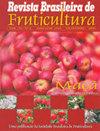umbu基质间的比色变化及生物特征参数的相关性
IF 0.9
4区 农林科学
Q4 HORTICULTURE
引用次数: 0
摘要
乌布树是巴西半干旱地区的特有树种。乌布因其社会经济重要性和质量属性的显著多样性而受到高度赞赏。本研究的目的是探讨不同颜色基质之间的相关差异,并评估质量的主要生物特征属性之间的相关性。据此,在商业成熟阶段对14种基质进行了探索,并提交了比色分析(a*, b*, C*和L*)和生物特征参数(果实质量,长度,宽度,形状,硬度,果皮百分比,种子,果肉和产量)的测定。采用Scott-Knott均值检验和树突图对比色参数进行评价,生物特征进行线性相关分析。结果表明,果皮以绿色为主,果皮多毛的果实光度指数(L*)最低。饱和度(C*)与参数b*有直接关系;此外,树状图表明在矩阵之间形成了四个基团。生物特征参数的相关分析显示出显著的趋势。因此,研究结果表明,所评估的参数可以为这些水果的选择和质量控制提供重要工具,因为所需的特性会根据其商业用途而变化。本文章由计算机程序翻译,如有差异,请以英文原文为准。
Colorimetric variation and correlation of biometric parameters between umbu matrices
Abstract The umbu tree is an endemic species and is found in the Brazilian semi-arid. Umbu is highly appreciated for its socioeconomic importance and significant diversity of quality attributes. This study aims to explore the color-related variations between umbu matrices, and to evaluate the correlation between the main biometric attributes of quality. With this, 14 matrices were explored at the commercial ripening stage and submitted to colorimetric analysis (a*, b*, C* and L*) and determination of biometric parameters (fruit mass, length, width, shape, firmness, percentages of peel, seed, pulp, and yield). The colorimetric parameters were evaluated by the Scott-Knott mean test and dendrogram, and biometrics were submitted to linear correlation analysis. It was observed that in the peel green predominates, compared to the pulp, and the lowest luminosity indexes (L*) consist of the fruits with hairy peel. The saturation (C*) has a direct relationship with parameter b*; in addition, the dendrogram indicates the formation of four groups between the matrices. The correlation analysis of biometric parameters showed significant tendencies. Therefore, the results reinforce that the parameters evaluated can provide an important tool in selecting and quality control these fruits, since the required characteristics change according to their commercial purpose.
求助全文
通过发布文献求助,成功后即可免费获取论文全文。
去求助
来源期刊
CiteScore
1.50
自引率
20.00%
发文量
34
审稿时长
4-8 weeks
期刊介绍:
The Revista Brasileira de Fruticultura (RBF) publishes technical articles and scientific communications in the area of fruit crops, referring to results of original searches and unpublished papers in Portuguese, Spanish or English, and 1 or 2 reviews per edition, of invited authors.

 求助内容:
求助内容: 应助结果提醒方式:
应助结果提醒方式:


